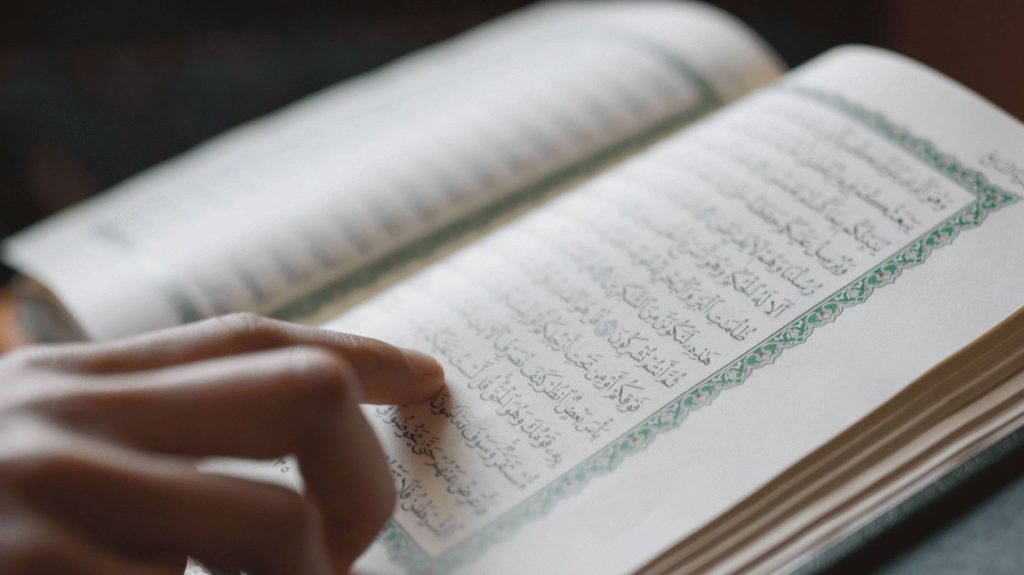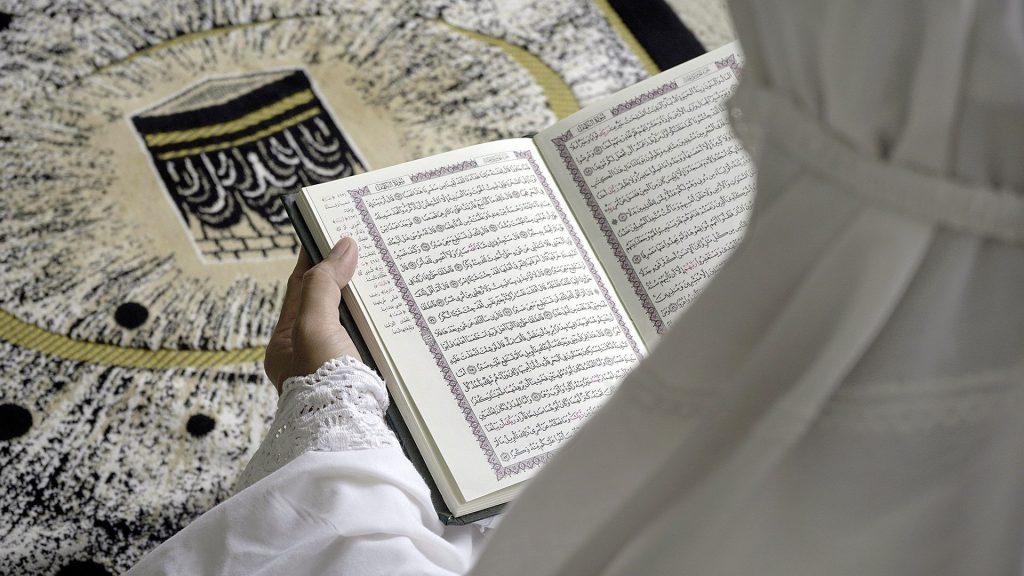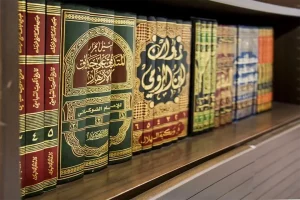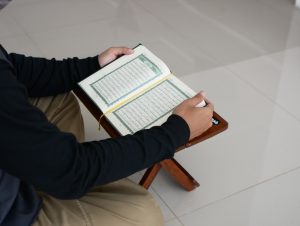Many Islamic Scholars have highlighted the meaning of Al Tajwd literally and technically.
Table of Contents
ToggleThe word Tajwid is derived from the Arabic root Jawwada, which means to make well, to improve or to make good. ‟ it also means to enable, to make possible or to bring forth what is better.
2 As a technical term Tajwid means to make good or to better the recitation of the Glorious Quan by giving each letter it’s right with regards to the correct way of pronunciation.
This would only be possible by taking into consideration the origins of pronunciation of Arabic letters and safeguarding the rules of recitation on combination of letters such as clear pronunciation (Izhr), assimilation (Idgham and substitution (lqlab).
Tajwid also means a mode of recitation of medium speed. This definition could serve as an explanation to a verse in the Grand Quran where Allah (S.W.T.) commands Muslims to recite the Noble Quran in a slow measured and rhythmic tone.
Scholars of Tajwid categorized the discipline into two parts, namely theoretical and practical. The theoretical aspect implies acquisition of knowledge of the rules of proper recitation of the Sacred Quran from reliable written sources.
While the practical aspect implies the application of the acquired theoretical knowledge for practical recitation of the Glorious Quran based on any of the various modes of recitations which were obtained from the Prophet Muhammad (S) and transmitted to us by the reciters (Qurrá, among the Sahäbah (R.A.) and the Tabiün (R.A).
It should be realized that a combination of theoretical and practical aspects of Tajwid is compulsory for any Muslim who seeks Allah’s pleasure whenever he recites the Glorious Quran.
Acquiring theoretical knowledge of Tajwid alone without putting it into practice would render it useless. This is because the purpose of acquiring the knowledge is to work with it. Al-Tajwid is one of the three branches of the Ulum al-Qirah, namely al-Tajwid (correct and good pronunciation of letters), Qirã at (knowledge of various readings and knowledge on the modes or speeds of recitation such as Hadr (normal talking speed), Tarteel slow speed) Tahqiq (slow speed with great care for the purpose of teaching and learning) and Tadwir (a speed between slow and normal).
The Sacred Quran was revealed to Prophet Muhammad (peace be upon him) with specific phonetic nuances, and the science of Tajwid aims to preserve this divine orchestration.
Tajwid serves multiple purposes: it protects the Grand Quran from distortion and change, ensures that the recitation is as close as possible to the Prophet’s own, and beautifies the reciter’s delivery. Understanding and applying the rules of Tajwid is a form of worship that reflects the reciter’s respect for the Holy Quran.
Key Tajwid Rules
- Nun Saakin and Tanween: These rules involve the pronunciation of the “nun saakin” (نْ – a “nun” with a sukoon) and “tanween” (double vowels that produce a “n” sound at the end of a word). There are four ways to pronounce these based on the letter that follows: clear (Izhar), merging (Idgham), changing (Iqlab), and concealment (Ikhfa).
- Mim Saakin: Similar to Nun Saakin and Tanween, Mim Saakin rules pertain to the pronunciation of the “mim” with a sukoon (مْ). The rules include clear pronunciation (Izhar Shafawi), merging (Idgham Shafawi), and concealment (Ikhfa Shafawi).
- Qalqalah: This rule applies to the echoing sound produced when certain letters (ق ط ب ج د) appear with a sukoon. The strength of the echo depends on the letter’s position in the word and sentence.
- Raa Pronunciation: The pronunciation of the letter “raa” (ر) varies depending on the characteristics of the letters surrounding it, specifically whether it is light (tarqiq) or heavy (tafkhim).
- Heavy and Light Letters (Tafkhim and Tarqiq): Tajwid distinguishes between heavy and light letters, which affect the quality of the recitation. Heavy letters are pronounced with a full mouth, while light letters are not.
- Madd (Elongation): This rule governs the extension of vowel sounds under certain conditions, enhancing the melodic flow of Quranic recitation.
Significance of ‘Ilm Al-Tajwid, llm al-Tajweed is significant in effecting recitation of the Holy Quran as it was revealed to Prophet Muhammad (S).
This is irrespective of whether the reciter is an Arab and master’s Arabic language or not.
It is a universal knowledge in theory and practice.
Thus it could be compared with any of the contemporary science. For instance, in the formula of addition in mathematics 1+1 =2. Wherever you are the answer is always 2, it will never be 3 or 5.
Likewise in ilm al Tajwid the rules of Izhär Idgham and Iqlab on combinations of letters of the Grand Quran are the same anywhere.
The Prophet (S) was reported to have said in a Hadith that “he is not one of us, he who does not recite the Holy Quran in a pleasant tone”) Recitation of the Grand Quran in a pleasant tone could only be possible by application of the knowledge of A1-Tajwid.
There are many Prophetic traditions which promise multiple rewards for recitation of the Holy Quran.

Among such Ahadih are. “Whoever read a letter (Hart) of the Holy Quran (the Book of Allah) he has 10 rewards”.
“Whoever is engaged in the recitation of the Sacred Quran, understands its meanings and teaches its sciences, he is best among them” “the best of you is he who learns the Grand Quran and teaches it.”
Knowledge of al-Tajwid is necessary in order to safeguard a reciter of the Holy Quran from committing mistakes. Such mistakes could in same cases tantamount to changing the meanings of Quranic verses and / or committing a sin instead of getting rewards from Allah (S.W.T) ‟ Basic Components of ‘Ilm Al-Tajwid. As a discipline in, Ulum al-Qiraah (sciences of recitation) the principal aspects of concern in Tajwid are correct pronunciation of Arabic letters in the Noble Quran and the correct length and emphasis given to vowel signs under different circumstances and combinations.
An overview on the scope of contemporary and earlier literature on Tajwid would reveal that books on the discipline emphasize the under listed which could be seen as its basic components.
Origins of pronunciation of Arabic letters (Makhaarij Al-Huroof).
There are differences of opinion among scholars on the number of origins of Letters. Al-Jazri, Khalil lbn Ahinad and some scholars maintained that there are seventeen (17) origins of pronunciation while other scholars like al-Shatibiy maintained that there are sixteen (16) origins.
Qutrab, Al-Jarmi and Ibn Ziyad on the other hand state only fourteen (14) origins. The first view that stated 17 is the most popular and accepted opinion.
These are the places of origin of pronunciation of all Arabic letters. On this opinion AI-Jazri stated in his book the Muqaddimah that: “The places of articulation of letters are 17 — and whoever has obtained knowledge would select such a number”.
There are five (5) places that are organs of speech in the human body from where all the seventeen places of articulation of letters emerged.
These are: The Importance of Tajwid in The Recitation of the Glorious Quran:
Emphasizing Its The throat – (Al-Halq) The tongue – (Al-lisan) The two lips – (Al-shafatayn) The nostril — (nose) – (Al-Khaishu) The chest or thoracic cavity – (Al-Jawfa) Each of these places has one or more other places of origin. For instance al-jawf has only one origin where the letters of prolongation (maddah) which are Alif, wäw and Yä are pronounced. On the other hand the throat (halq) has 3 origins which are the upper, middle and lower portions from where different letters such as Ha, Alif and Jim are pronounced.
The forms of pronunciation of letters
This means the quality or description of how to pronounce Arabic letters from their origins. There are two groups of forms of pronunciation of letters.
The first group are those which are independent without opposites.
These include whistling (Al-Safir) Shaking the voice (Qalqalah), easiness (Al-liyn), tilting (Al-inhiraf), light pronunciation (Al-tarqiq), spreading (A l-tafasshi) and prolongation (Al-Istitalah).
The second group are those that have their opposites as follows: Form opposite Lowering the voice Outward pronunciation („Al- Hams,) (Al-Jahr) Emphasis in pronunciation Softening of pronunciation (Al- Shiddah) (Al- Rikhawali) Raising the tongue Lowering the tongue (Al- Isti la) (Al-Istidl). Attachment Separation (Al- Jtbãq) (Al- Jnfitáh,) Sharpness of the tongue Complete usage of the tongue (Al- Idhlaq) and (Al- Ithmat).
Signs and styles to be observed while reciting the Holy Quran
Such as how to start the recitation, where a waqf (pause) is either preferred, necessary or compulsory. Where to make a full-stop, where there should be no full stop and where it is preferable to make it.
Also how to continue with the recitation in a situation where the reciter stops for taking a breath at a place where there should be no pause or pull-stop before the end of a verse) or where to make prostration of recitation.
General rules which are applicable in all modes of recitations
Such as Al-Izhãr, Jdghrn, Iqlãb silencing (Ikhfä,), and prolongation (A l- Maddah,).
The word Tajwid linguistically means proficiency or doing something well.
It comes from the same root letters as the word Jayyid in Arabic (meaning good): Jeem, Waw and Daal When applied to the Noble Quran, it means giving every letter of the Glorious Quran its rights and dues of characteristics when we recite the Holy Quran and observing the rules that apply to those letters in different situations.
We give the letters their rights by observing the essential characteristics of each letter that never leave it. And we give them their dues by observing the characteristics of each letter that are present in them some of the time and not present at other times.
The Sacred Quran was revealed with Tajwid rules applied to it. In other words, when the angel Jibreel (alaihis salaam) recited the words of Allah to the Prophet Muhammad (sallallaahu „alaihi wa sallam) he recited them in a certain way and he showed the Prophet (sallallaahu „alaihi wa sallam) the ways in which it was permissible to recite the Grand Quran.
So it is upon us to observe those rules so that we recite it in the way it was revealed. At the time of the Prophet (sallallaahu „alaihi wa sallam) there was no need for people to study Tajwid because they talked with what is now known as Tajwid so it was natural for them. When the Arabs started mixing with the non-Arabs as Islam spread, mistakes in Quran recitation started appearing, so the scholars had to record the rules. Now, because the everyday Arabic that Arabs speak has changed so much from the Classical Arabic with which the Holy Quran was revealed, even Arabs have to study Tajwid.

The Holy Quran is the word of Allah, and its every syllable is from Allah. Its recitation must be taken very seriously.
The purpose of the Science of Tajwid in essence is to make the reciter proficient in reciting the Grand Quran, observing the correct pronunciation of every letter with the rulings and characteristics which apply to each letter, without any exaggeration or deficiency.
And so through this the reciter can recite the Noble Quran upon the way of the Prophet (sallallaahu alaihi wa sallam) who received it from Jibreel who received it from Allah (subhanahu wa ta‟aala) in the Classical Arabic dialect that it came down in.
Arabic letters each have a makhraj – an exit or articulation point – in the mouth or throat from which they originate and they also each have sifaat – attributes, or characteristics – particular to them.
Knowing the makhraj and sifaat of each letter is an important part of Tajwid. Sometimes two letters have very similar exits which makes mixing them up easy.
So if a person does not know the attributes of each letter there is a danger that he will change the meaning of the words in Quran recitation. Observing the rules of Tajwid in reciting protects the reciter from making mistakes in reciting the Holy Quran.
The ruling of reading with Tajwid Muhammad bin Al-Jazaree the Great Quran and Hadeelh scholar of the 9th Century (Hun) says in his famous poem detailing the rules of Tajwid: And applying Tajwid is an issue of absolute necessity, whoever doesn’t apply Tajwid to the Purly Quran, then a sinner is he.” Sheikh Zakariaa Al-Ansari [died in 926 H.) said in explanation of this verse in his book: Sharh al-Muqaddimah al-Jazariyyaa; “It is required to observe all of the Arabic rules in that which changes it and ruins the meaning” So he regarded it as an obligation to keep away from the major mistakes in reciting the Holy Quran.
The scholars have divided the types of mistakes one might fall into when reciting the Grand Quran into two types:
- Clear mistakes: which usually change obvious things and change the meaning.
- Unobvious (hidden) mistakes: for which one may need to study Tajwid rules. And the majority of scholars agree that applying the Tajwid rules of Quran such that the Clear Mistakes are avoided is an individual obligation (Fard Ayn) upon every Muslim who has memorized part of or all of the Holy Quran. As for applying all of the rules of Tajwid and avoiding the unobvious mistakes then it is (Fard Kifaayah) upon the Muslim. That is, there must be some students of knowledge who have knowledge of that. This is because the Grand Quran was revealed with the Tajwid rules applied to it and the Prophet (sallallaahu alaihi wa sallam) recited it back to Jibreel in that way and the Companions of the Prophet (sallallaahu alaihi wa sallam) read it in that way, so it is an established Sunnah.
The Clear mistakes must be avoided by all and to avoid them one must memories and read attentively and have knowledge of some basic aspects of Tajwid. If a person falls into the clear mistakes, this is considered a sin and tim Taymiyyah even regarded it undesirable for a student of knowledge (i.e. someone who knows Tajwid) to pray behind a person who makes clear mistakes in their salad/h. As for the unobvious mistakes, then the ruling on them is lighter and the recitation of a person falling into this type of mistake is regarded as lacking in completeness but prayer behind such a person is sound. The List below shows what type of mistakes fall under each category. Clear mistakes: Mistakes in words which are clear and conspicuous, usually changing the meaning. Mistakes related to correct pronunciation of letters so that letters are not mixed up. Scholars and the ordinary Muslims should avoid these. Examples of Clear mistakes: Changing one letter into another, or a short vowel (harakah) into another, (changing Fat hah into Damma or the letter Qaaf into Kaaf) Not observing the elongations (Madd) at all. Reciting them quickly as if there is no made/so that they turn into the length of a vowel. Making a madd letter out of a normal harakah. Stopping or starting at an incorrect place so that the meaning is spoilt. Like stopping at ilaaha‟ (There is no God), without completing Illallaah (except Allah). Unobvious mistakes: Mistakes which are to do with perfecting pronunciation and are not obvious. Known only those who have studied Tajwid rules or experts in this field. Ordinary Muslims may not know these or perceive these as mistakes. Examples of Unobvious mistakes:
- Not being totally exact with the elongation of letters: (making the madd shorter or longer by 1/2 or even 1/4 degree etc.)
- Not observing the attributes of each letter perfectly: (Slightly rolling the Raa‟, exaggerating the N‟ sound in Noon etc.)
- Not observing the rules with which to pronounce letters when they are next to each other (like not merging certain letters that should be merged (idghaam) and not clearly pronouncing those which should be clearly pronounced (idhhaar) etc.)
- Making light letters sound heavy and heavy letters sound light (Except if by doing this you change a letter into another; in this case it would be an obvious mistake) And of the proofs that the scholars bring to show the obligation of Tajwid and that it is an established sunnah is that Allah says in the Grand Quran, the meaning of which is: And recite the Holy Quran (aloud) in a (slow and melodious) style (tarteel), (Surah Muzzammil, aayah ).

Ali ibn Abi Talib (radi Allahu anhu) said in the explanation of this aayah: “at-Tarteel is Tajwid of the letters and knowing where to stop (correctly)”.
And of the proofs also is that Allah says in the Grand Quran, the meaning of which is: Those who we have given the Book to, give it its right in recitation (recite it as it should be recited) ‟ (Surah alBaqarah, aayah 121). And of the rights of reciting correctly is reciting it the way it was revealed.
There are various ahadeeth also showing us the importance of Tajwid. Umm Salamah was asked about the recitation of the Prophet (sallallaahu alaihi wa sallam) and she described it as a recitation “clearly-distinguished letter by letter‟. Sa‟eed bin Mansoor relates in his Sunan that a man was reciting the Holy Quran to Abdullah bin Masood and he recited; “Innamas sadaqaatu lii fuqara-i wal masaakeen”, so Ibn masood said: “This was not how the Messenger of Allah (sallallaahu alaihi wa sallam) recited it to me So the man asked, “How did he read it to you oh Aba Abdir-Rahman‟ So he said “Lil Fuqaraaaa-i wal masaakeen”, he elongated the word Fuqaraa and the knowledge of the different lengths of elongation is also from the rules of Tajwid Reciting the Noble Quran melodiously:
- The Prophet (sallallaahu alaihi wa sallam) used-to recite the Grand Quran in slow, measured, rhythmic tones as Allah had instructed him, not hurriedly, but rather “he would recite a swab in such slow rhythmic tones that it would be longer than it would seem possible.”
- He would stop at the end of each aayah.
- He commanded people to recite in a beautiful voice in a pleasant melodious tone. He said “Beautify the Grand Quran with your voices [for a fine voice increases the Sacred Quran in beauty]” and he said “He who does not recite the Holy Quran in a pleasant tone is not of us.” Unfortunately, all too often we find people reciting the Noble Quran quickly and without changing their tone and without any feeling.
- We should put all our efforts into reciting the Holy Quran with as much feeling as we can! Have you ever prayed behind an Imam who read with feeling? Well the Prophet (sallallaahu alaihiwa sallam) said “Truly the one who has one of the finest voices among the people for reciting the Sacred Quran is the one whom you think fears Allah when you hear him recite.”
- And once when the Prophet (sallallaahu alaihi wa sallam) complimented Abu Moosaa alAsh‟ari on the beauty of his recitation, Abu Moosaa said “Had I known you were there, I would have made my voice more pleasant and emotional for you.” Let us remember, that the Grand Quran is the word of Allah. In it we find exhortations, warnings, glad tidings, parables, stories of the past, commands and prohibitions. Aayaat to make us think, reflect, cry, fear, hope, love, fall down in prostration! How can we recite all of this without feeling!? When we recite an aayah of Quran we should be imaging that we are trying to feel and convey the fill message behind that aayah. Perhaps some of us don’t feels confident. I believe that this lack of confidence comes partly from not knowing the rules of Tajwid correctly and so fearing that We will make, mistakes and partly from not understanding the meaning of what we are reciting. So let‟ us work hard to remove these two obstacles by learning to/weed and working towards learning Arabic.
In conclusion, Tajwid is a fundamental aspect of the Sacred Quran that holds immense significance for Muslims. It ensures the preservation of the Holy Quran’s authenticity, enhances the understanding and interpretation of the text, and serves as a means of honoring the divine word. By mastering the principles of Tajwid, individuals can deepen their connection with the Noble Quran and engage with it in a more meaningful and reverent manner.

















